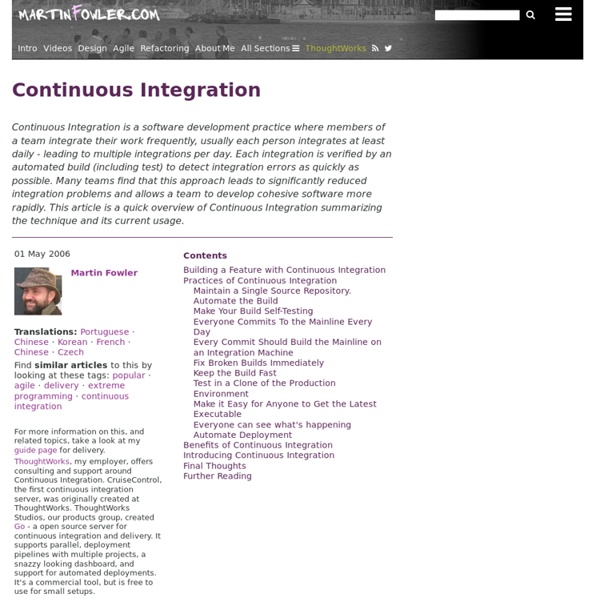Merciless Refactoring
Home → Blog → Merciless-Refactoring Let's Code: Test-Driven JavaScript, my new screencast series on rigorous, professional JavaScript development, is now available! Check out the demo video here. Print by James Shore 02 Sep, 2005 Ron Jeffries started an interesting topic on the XP mailing list. I thought this was a great topic. Here are the most common refactoring problems I see with XP teams: Teams that don't refactor enough. These three issues aren't mutually exclusive and may reinforce each other. So what I would like to see is teams that do intraclass micro-refactorings every hour, do interclass refactorings multiple times per pair-week, and identify big-picture "architectural" refactorings every 2-12 months. I'd like to see teams identify one or two (max) architectural refactorings that are based on (a) reflecting on problems in the existing design and (b) how to improve the existing design; and use that architectural direction to guide their intra- and inter-class refactorings.
What is continuous integration (CI)? - Definition from WhatIs.com
What is continuous integration (CI)? Continuous integration (CI) is a software engineering practice in which isolated changes are immediately tested and reported on when they are added to a larger code base. The goal of CI is to provide rapid feedback so that if a defect is introduced into the code base, it can be identified and corrected as soon as possible. Continuous integration software tools can be used to automate the testing and build a document trail. Continuous integration has evolved since its conception. According to Paul Duvall, co-author of Continuous Integration: Improving Software Quality and Reducing Risk, best practices of CI include: Committing code frequently. CI originated from within the extreme programming paradigm but the principles can be applied to any iterative programming model, such as agile programming. This was last updated in July 2008 Email Alerts Register now to receive SearchSoftwareQuality.com-related news, tips and more, delivered to your inbox.
Comparison of continuous integration software
Continuous integration describes a set of software engineering practices that speed up the delivery of software by decreasing integration times. Software that accomplish this practice is called continuous integration software. Comparison[edit] SCM system support[edit] References[edit] External links[edit] CI Feature Matrix
Clean Code: A Handbook of Agile Software Craftsmanship (9780132350884): Robert C. Martin
Meta Build Systems
This is a story about my search for a hassle-free cross-platform open source (meta-/meta-meta-) build system. For our open source Bullet physics engine, I’ve been distributing the source code in a way that should make it as easy as possible to build out-of-the box. This means that for all supported platforms, the user (a developer who downloaded the Bullet SDK) should be able to download and unzip the zipfile or tarball on his machine, and get started as soon as possible. It should be hassle-free for the user but also for me, so I rather don’t manual updating too many files for each release. Aside from all the different platforms, we need to also support various compilers, compiler settings and integrated developer environments (IDEs). Here are a couple of build systems and modifications that I tried or considered to try: Visual Studio project files. autotools: for most unix flavors, autotools does a great job.
Rudder » Screenshots
Collection of screenshots from the Rudder web interface Home Configuration management Rules Rules list Rule compliance Rules details Directives Directives list Directive details Parameters Node Management Nodes management Nodes list Node details Node compliance Groups Search Nodes Groups List and Details Utilities Event logs Change Request Change requests List Change request Details Archives Administration Database management API accounts Technique library Policy server configuration
Refactoring Home
What is Jidoka ?
Jidoka is a Japanese term used for automation and being widely used in Toyota Production System (TPS), Lean Manufacturing and Total Productive Maintenance (TPM). Concept is to authorize the machine owner (operator) and in any case if a problem occurs on flow line, operator can stop the flow line. Ultimately defective pieces will not move to the next station. This concept minimizes the defects, over production and minimizes wastes. Also its focus is to understand the causes of problems and then taking preventive action to reduce them.History of Jidoka is back in early 1900’s, when first loom was stopped due to breakage of thread. The concept of automated line is being used to relieve workers and minimize human related errors. The purpose of Jidoka implementation is to diagnose the defect immediately and correct it accordingly. Jidoka is being effectively used in TPM, Lean Manufacturing and providing substantial benefits to the organizations.
Rundeck.org - Open Source Workflow Automation
Home - pyccuracy - GitHub
George Dinwiddie's blog » How easy is it for your programmers to fix problems?
A programmer, writing some new code, looks into some existing code that she needs to use. Something doesn’t look quite right. In fact, there’s a bug. Whether no one’s triggered it, or they have but their complaints haven’t reached anyone who will do something about it, is hard to say. In such a situation, I would prefer to write a new test illustrating the bug, fix it, and check both the test and the fix into source control. Maybe, however, there are policies, either explicit or tacit, that prevent such quick resolution. Perhaps there is a “ticketing” system that requires opening a formal change ticket before introducing a change. Perhaps someone else is the “owner” of this code, and you need to ask their permission before fixing it. I’ve often seen organizations that lock down their “architectural framework” code on the assumption that only their most senior developers can be trusted to work on it. Perhaps various teams have to analyze what effect the change will have on their code.



